 4
4 x = -2
General Formulas and Concepts:
Pre-Algebra
Order of Operations: BPEMDAS
Brackets Parenthesis Exponents Multiplication Division Addition Subtraction Left to RightEquality Properties
Algebra I
Function NotationStep-by-step explanation:
Step 1: Define
f(x) = 3x - 1
f(x) = -7
Step 2: Solve for x
Substitute: -7 = 3x - 1Isolate x term: -6 = 3xIsolate x: -2 = xRewrite: x = -2
• when f(x) is 7,

 4
4 x = -2
General Formulas and Concepts:
Pre-Algebra
Order of Operations: BPEMDAS
Brackets Parenthesis Exponents Multiplication Division Addition Subtraction Left to RightEquality Properties
Algebra I
Function NotationStep-by-step explanation:
Step 1: Define
f(x) = 3x - 1
f(x) = -7
Step 2: Solve for x
Substitute: -7 = 3x - 1Isolate x term: -6 = 3xIsolate x: -2 = xRewrite: x = -2f(7) = 22
Step-by-step explanation:
1. f(x) = 3x + 1
2. f(7) = 3(7) + 1
3. f(7) = 21 + 1
 11
11 x = 2
Step-by-step explanation:
Step 1: Define
f(x) = 3x + 1
f(x) = 7
Step 2: Substitute
7 = 3x + 1
Step 3: Solve for x
6 = 3x
x = 2
 1
1 1. f(x) = 1/4x − 1. B)The line will be less steep. The slope is lower now
2. C)x-intercept (−1/3 , 0). Replacing f(x) = 0 we get x = -1/3
3. B)horizontal line with a slope of zero. The slope is 0 because there is no x in the equation.
4. D)Line changes from decreasing to increasing. The slope changed from negative to positive.
5. See first graph attached
6. See second graph attached. g(x) = (1/3)*x
7. C)The rate of change is different, but the y-intercepts are the same. The rate of change of Mike is negative because he withdraws $25 each week. The y-intercepts of Mike is $200 because that was his initial deposit.
8. B)shifts the line 7 units down. f(x-7) translates f(x) 7 units to the right, given the slope is positive ( = 1) then f(x) is translated 7 units down.
9. No graph is shown
10. C)g(x) = x - 3. g(x) = f(x) - 3, so g(x) is f(x) translated 3 units down.
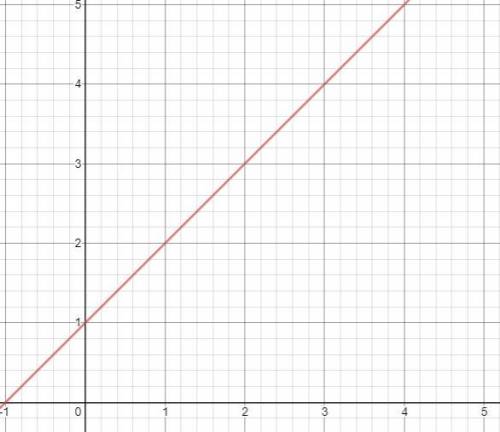
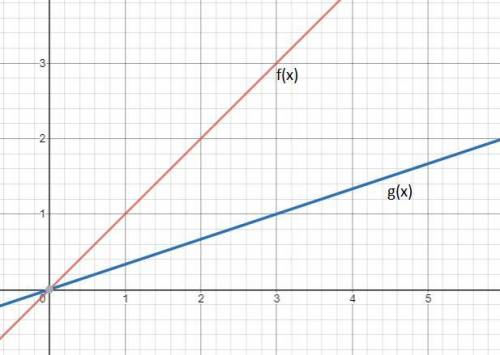
 1
1 1. f(x) = 1/4x − 1. B)The line will be less steep. The slope is lower now
2. C)x-intercept (−1/3 , 0). Replacing f(x) = 0 we get x = -1/3
3. B)horizontal line with a slope of zero. The slope is 0 because there is no x in the equation.
4. D)Line changes from decreasing to increasing. The slope changed from negative to positive.
5. See first graph attached
6. See second graph attached. g(x) = (1/3)*x
7. C)The rate of change is different, but the y-intercepts are the same. The rate of change of Mike is negative because he withdraws $25 each week. The y-intercepts of Mike is $200 because that was his initial deposit.
8. B)shifts the line 7 units down. f(x-7) translates f(x) 7 units to the right, given the slope is positive ( = 1) then f(x) is translated 7 units down.
9. No graph is shown
10. C)g(x) = x - 3. g(x) = f(x) - 3, so g(x) is f(x) translated 3 units down.


 31
31  31
31 











 (as constant)
(as constant) 3
3
























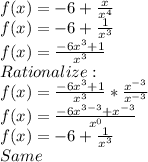

 where,
where,
 9: answer would be 9+9 = 18
9: answer would be 9+9 = 18 9: answer would be 9-9 = 0
9: answer would be 9-9 = 0 , hence limit doesn't exist.
, hence limit doesn't exist. where,
where,
 8; hence, limit doesn't exist.
8; hence, limit doesn't exist.f(x) = 1/(x-9).
Table:
x f(x)=1/(x-9)
----------------------------------------
8.9 -10
8.99 -100
8.999 -1000
8.9999 -10000
9.0 -∞
Below the graph is attached! As you can see in the graph that at x=9, the curve approaches but NEVER exactly touches the x=9 line. Also the curve is in downward direction when you approach from the left. Hence, -∞, x =9 (correct)
14. Ans: -6
s(t) = -2 - 6t
Inst. velocity = 
Therefore,

At t=2,
Inst. velocity = -6
15. Ans: +∞, x =7
f(x) = 1/(x-7)^2.
Table:
x f(x)= 1/(x-7)^2
--------------------------
6.9 +100
6.99 +10000
6.999 +1000000
6.9999 +100000000
7.0 +∞
Below the graph is attached! As you can see in the graph that at x=7, the curve approaches but NEVER exactly touches the x=7 line. The curve is in upward direction if approached from left or right. Hence, +∞, x =7 (correct)
-i
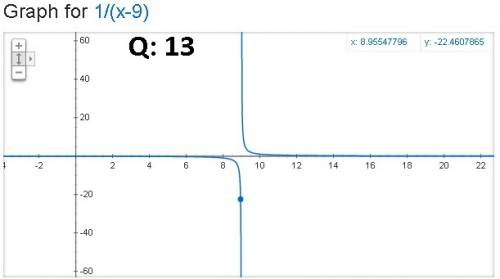
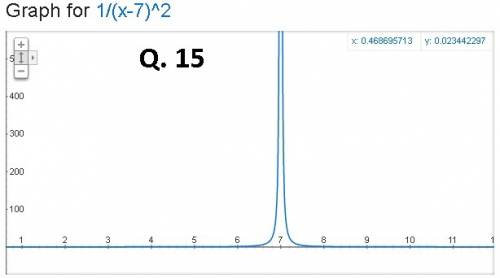

It will provide an instant answer!
